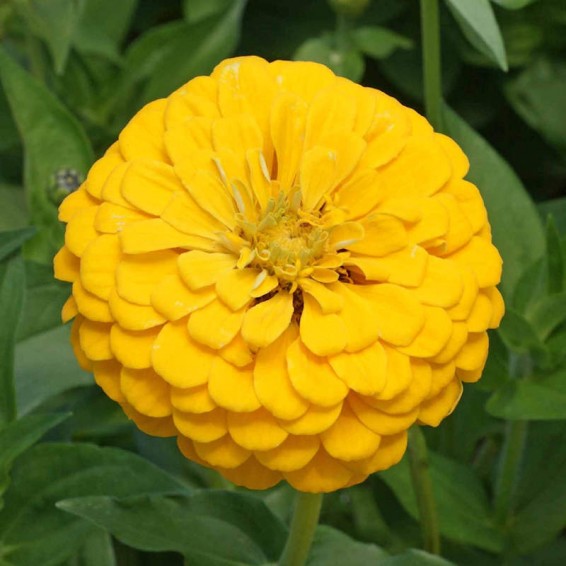Canary Bird Zinnia Seeds
- HOW TO GROW
- FAST FACTS
- REVIEWS
HOW TO GROW
Sowing: Direct sow in spring; this Canary Bird Zinnia seed germinates best in warm soil. Plant just below the surface and keep the soil lightly moist until germination, which usually occurs within 7-10 days. Seedlings do not transplant well.
Growing: Water seedlings regularly until they become established, but do not over water. Though they flourish with occasional watering in dry weather, mature plants tolerate some drought. This plant grows best in rich soil, and may need light fertilization for best blooming. Pinch off the growing stems to encourage bushiness, and deadhead to prolong blooming. This plant attracts butterflies and bees.
Harvesting: For cut flowers, choose stems with flowers that have just opened. Strip the foliage that will fall below the water level, and place in water immediately.
Seed Saving: After their petals drop off, the centers of the flowers will darken and develop tight clusters of yellow zinnia seed at the base. As soon as the seed heads have turned dark brown, remove them and spread them out to dry for several days. Thresh the dried heads to separate the small, arrow-shaped seeds from the chaff. Store the cleaned Canary Bird Zinnia seed in a cool, dry place.
FAST FACTS
Latin Name: Zinnia elegans
Species Origin: Introduced US Flower
Type: Garden Flowers
Life Cycle: Annual
USDA Zones: 1, 2, 3, 4, 5, 6, 7, 8, 9, 10, 11, 12
US Regions: California, Mountain, Arid/Desert, Plains/Texas, Midwest, Northern, Northeast, Southeast
Seeds per Ounce: 4,250
Stratification: No Stratification
Germination Ease: No Stratification
Sunlight: Full Sun
Height: 36 Inches
Color: Yellow
Bloom Season: Blooms Late Summer, Blooms Early Fall
Uses: Cut Flowers, Deer Resistant
Excellent product and company
This is my second time ordering zinnia seeds from Everwilde. Seeds arrived promptly, securely, sprouted quickly 5 days, and produced lovely flowers all spring summer. Thank you!
looks good on package...
I have not planted these as of yet, i will write a review after the summer and let you know how they turned out..The packaging is beautiful and I received my order fast
Great Canary Bird Zinnia
Very good packaging and hopefully will be as good as the other Zinnias.
DESCRIPTION
HOW TO GROW
Sowing: Direct sow in spring; this Canary Bird Zinnia seed germinates best in warm soil. Plant just below the surface and keep the soil lightly moist until germination, which usually occurs within 7-10 days. Seedlings do not transplant well.
Growing: Water seedlings regularly until they become established, but do not over water. Though they flourish with occasional watering in dry weather, mature plants tolerate some drought. This plant grows best in rich soil, and may need light fertilization for best blooming. Pinch off the growing stems to encourage bushiness, and deadhead to prolong blooming. This plant attracts butterflies and bees.
Harvesting: For cut flowers, choose stems with flowers that have just opened. Strip the foliage that will fall below the water level, and place in water immediately.
Seed Saving: After their petals drop off, the centers of the flowers will darken and develop tight clusters of yellow zinnia seed at the base. As soon as the seed heads have turned dark brown, remove them and spread them out to dry for several days. Thresh the dried heads to separate the small, arrow-shaped seeds from the chaff. Store the cleaned Canary Bird Zinnia seed in a cool, dry place.
FAST FACTS
Latin Name: Zinnia elegans
Species Origin: Introduced US Flower
Type: Garden Flowers
Life Cycle: Annual
USDA Zones: 1, 2, 3, 4, 5, 6, 7, 8, 9, 10, 11, 12
US Regions: California, Mountain, Arid/Desert, Plains/Texas, Midwest, Northern, Northeast, Southeast
Seeds per Ounce: 4,250
Stratification: No Stratification
Germination Ease: No Stratification
Sunlight: Full Sun
Height: 36 Inches
Color: Yellow
Bloom Season: Blooms Late Summer, Blooms Early Fall
Uses: Cut Flowers, Deer Resistant
Reviews
Review
Excellent product and company
This is my second time ordering zinnia seeds from Everwilde. Seeds arrived promptly, securely, sprouted quickly 5 days, and produced lovely flowers all spring summer. Thank you!
Review
looks good on package...
I have not planted these as of yet, i will write a review after the summer and let you know how they turned out..The packaging is beautiful and I received my order fast
Review
Great Canary Bird Zinnia
Very good packaging and hopefully will be as good as the other Zinnias.





